
The game is called 'go'. Play of the game is a competition as to a win.
The game is played on a grid. The grid consists of lines and their intersections, called points. A grid has 19x19 points. Other sizes are conceivable.
Two points are adjacent via a line. A path connects two points via lines.

Each point has a color: black, white, or empty.

The game is played between two players. The black color belongs to one player. The white color belongs to the other player.
The game starts from an empty grid. The start of alternation is done by black.

A point may be surrounded.
Each point of a connected set of points of one color is surrounded if and only if a point of the set is surrounded. A black point can be surrounded by white. A white point can be surrounded by black. An empty point can be surrounded by either black or white. A point of a color is not surrounded if it can reach both other colors first after its color.
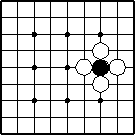
The black point is surrounded. No leaving path reaches empty first after black. All leaving paths reach white first after black.
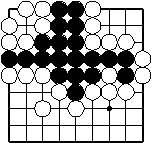
Each black point is surrounded. All black points are connected and surrounded as a set. No leaving path reaches empty first after black. All leaving paths reach white first after black.
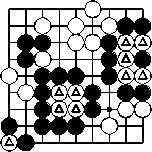
All marked white points are all surrounded white points. No path leaving one of the marked points reaches empty first after white. All leaving paths reach black first after white.

The only surrounded point is the empty point adjacent to four white points. It is surrounded by white. Any leaving path from the point reaches white first after empty. No leaving path reaches black first after empty.
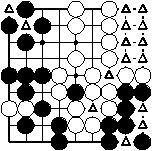
All marked points are all surrounded empty points. Some are surrounded by black; the others are surrounded by white. All other empty points may reach black or white first after empty.
A move is of one of the two players. A move alters the points' colors in the following order:
Mostly only the first item applies. The rarely occuring second and third items are also known as removal and suicide.

This is a move of the black player. It colors the empty point 1 with black color.

This is a move of the white player. It colors the empty point 1 with white color.

This is a move of the white player. It colors the empty point 1 with white color. Then a black point is surrounded. This black point becomes empty. This ends the color change of the move.

This is a move of the white player. It colors the empty point 1 with white color. Then several black points are surrounded. They form two connected sets. They all become empty.

This is a move of the black player. It causes only black points to be surrounded. They become empty.
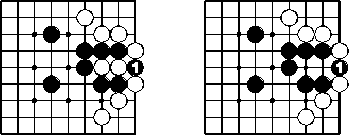
This is a move of the black player. It causes points of black and white to be surrounded. After the coloring of the empty point 1 with black the surrounded points of the opponent white are emptied first. Then no point is surrounded any longer. The move is ended.
A pass does not change colors of points. It just lets alternation continue with the opponent of the passing player.

If alternation is to continue with white, then white may pass. He cannot improve the colors of the points. So he need not to move. To let alternation proceed he has to pass instead.
If in alternation both players successively pass, then this ends the game. At the game end the win is determined.
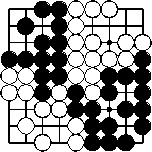
White passes, then black passes. Both cannot improve something using moves, so they end the game.
The game is played in alternation of the two players. Play is to be done with either a move or a pass.

The alternation starts with black. Then each player makes one move.

Alternation proceeds for most time of a game with moves only. Here black 53 is the first pass. White still can improve the points' colors with his move 54. Then black 55 is a pass and white 56 is a pass. This ends alternation and the game. Now the win can be determined.

In the late stage of alternation white 1 is a pass. Black still moves with 2. Then white 3 and black 4 are passes ending the game.
Repetition of all points' colors is prohibited after a move. This refers to the colors after the performance of a move including all effects on surrounded points. A move that would lead to repetition cannot be done.

Move 2 is prohibited due to repeated grid point colors as before move 1.

2 would repeat an earlier grid coloring and is not allowed. Now a move is required to color another empty point instead. Later black could get a chance to move at 2.
The aim of the game is to win. The win is determined at the end of a game. For each player numbers of points are evaluated as
The colored points are the points of his color. The empty points are those surrounded by his color. The higher number of points determines the win. Mostly only one player wins. If both point numbers are even, then both players win.
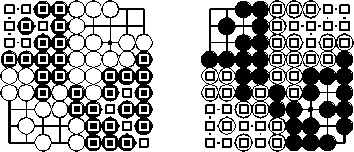 black - white
black - white
40 points count for black's number, 41 points for white's number. White has the higher number and wins the game.
 black - white
black - white
44 points count for black's number, 35 points count for white's number. The two points reaching black and white do not count. Black has the higher number and wins the game.
 black / white
black / white
Each player's number of points is 40. This rare occasion is caused by the one empty point reaching black and white. Both players win.